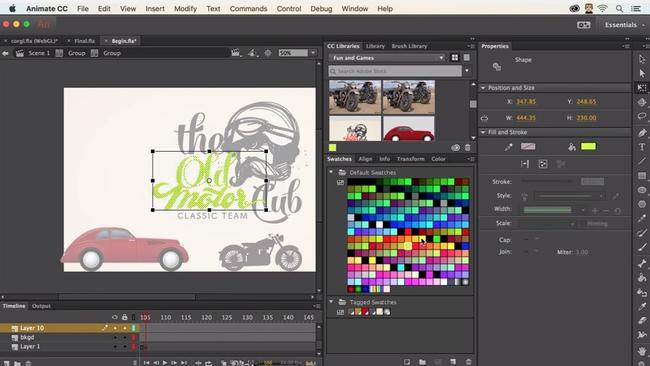Adobe Animate, Experience Design boon for Flash, app developers
Adobe has taken its time but there’s good news at last for Flash developers.

It has been six years since Steve Jobs put the kibosh on Adobe Flash. Previously Flash had been the go-to tool for building animations and interactive graphics on websites. Go to a news site and you’d see animated timelines, headline tickers and quizzes all built in Flash.
But Jobs had refused to integrate Flash on Apple mobile devices, declaring it had had its day. “The avalanche of media outlets offering their content for Apple’s mobile devices demonstrates that Flash is no longer necessary to watch video or consume any kind of web content,” he said.
Across time the world adopted the new HTML5 standard, which is supported by browsers natively. But it meant about two million Flash developers globally had well-honed development skills that were going to waste. It has taken Adobe almost a half-decade to address that. Its latest version of Flash Professional, renamed Adobe Animate, lets developers create Flash designs as before but export them as JavaScript for HTML 5 animation. It may not be perfect yet. You’ll need some JavaScript skills. And I’m aware of developers having teething problems. But at least they have somewhere to go with those skill sets.
Adobe Animate is one of the company’s more recent Creative Cloud offerings spruiked at its annual Make It conference in Sydney last week. If Animate empowers old Flash developers, Adobe Experience Design should empower a wider body of ordinary folk to be app developers. It’s currently in preview.
Using drag-and-drop technology, it makes it relatively simple to build information apps about, say, an upcoming conference; a resume app that shows off samples of your published works or architectural designs; an app for a local medical, dental or legal practice; or even an app that displays a restaurant menu.
You drag and drop logos, images and designs on to the display, add and label buttons and install navigation elements, all visually. You can quickly duplicate and modify elements such as buttons and menu selection items. There are also preset user interfaces for various types of devices.
Adobe is not the only company seeking to make it easier for less technically minded people to build custom apps. Apple subsidiary FileMaker is pitching its latest FileMaker version 15 platform to business and boasts among its local users Sydney Trains, Carlton Football Club, and Akubra Hats.
Its latest version supports apps that make use of Apple’s Touch ID, the newer 3D Touch pressure feature found on iPhone 6s and 6s plus, and iBeacon applications typically for retail.
You’d be forgiven for not knowing that Apple had a subsidiary called Filemaker, formerly Claris, as it was spun off way back in 1987. It had its roots in the early days of Apple. Its software output has included ClarisWorks which became AppleWorks for Macintosh.
Meanwhile the tools for editing immersive 360 video that forms the building blocks of virtual reality presentations are porting across into mainstream computing.
At Make It last week, Karl Soule, Adobe’s regional video evangelist, went through the upcoming capabilities of Adobe Premiere Pro to edit 360-degree/VR video, features that were highlighted at last month’s National Association of Broadcasters show in Las Vegas. The updates will be available midyear.
VR, or virtual reality, was big at that NAB conference. In one demonstration, people in the show’s south hall could put on a VR headset and watch a band performing live in the north hall. “It was like I was standing on stage looking around,” Soule said of the event.
Presently, those wanting to edit 360-degree video can use Mettle’s SkyBox 360/VR, a plug-in for Premiere Pro and After Effects. It handles transitions, title positioning and other special effects that can be applied to 360-degree video.
It seems Adobe isn’t out to trounce Mettle’s business with its own offerings. Soule says Adobe will continue working with Mettle. “What we’re adding in Premiere is a new viewing option. There’s going to be a VR viewer button that you can toggle on and off. It will take the video you have on the timeline and put it into a 360 (degree) pan around experience.”
He says Adobe is pushing the boundaries by supporting higher raster video beyond 4K. “We thought 4K was the be-all and end-all for a while, and then immediately the camera makers started coming up with 5K cameras, 6K cameras.
“We just announced support for the new Red 8K Weapon camera. If you’re shooting at 8K and delivering at 4K, the algorithms in the computer will scale the video down, resulting in a sharper, crisper image than what you would typically see from a 4K single-sensor camera directly.”
Although 8K video can be adopted for production at the bleeding edge, he says 4K is likely to remain the optimal viewing experience. But there are exceptions.
“Some of the Japanese broadcasters like NHK are talking about doing 8K theatre projections. Some of the more popular Olympic events would be broadcast in high resolution in local theatres so you’ll be able to watch an 8K projection of what’s happening at one of these events. That’s something you’re probably going to see more of in the future,” Soule says.
He says Premiere Pro has native support for the latest standard for 4K video, high dynamic range or HDR.
All of the above suggests that if you’re into even rudimentary software development, there’s a rich bag of tools coming your way and lots of opportunities ahead.


